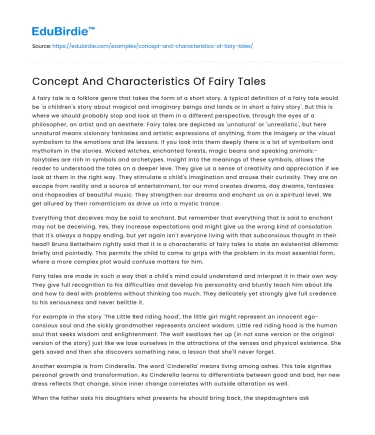A fairy tale is a folklore genre that takes the form of a short story. A typical definition of a fairy tale would be 'a children's story about magical and imaginary beings and lands or in short a fairy story'. But this is where we should probably stop and look at them in a different perspective, through the eyes of a philosopher, an artist and an aesthete. Fairy tales are depicted as 'unnatural' or 'unrealistic', but here unnatural means visionary fantasies and artistic expressions of anything, from the imagery or the visual symbolism to the emotions and life lessons. If you look into them deeply there is a lot of symbolism and mytholism in the stories. Wicked witches, enchanted forests, magic beans and speaking animals:- fairytales are rich in symbols and archetypes. Insight into the meanings of these symbols, allows the reader to understood the tales on a deeper leve. They give us a sense of creativity and appreciation if we look at them in the right way. They stimulate a child's imagination and arouse their curiosity. They are an escape from reality and a source of entertainment, for our mind creates dreams, day dreams, fantasies and rhapsodies of beautiful music. They strengthen our dreams and enchant us on a spiritual level. We get allured by their romanticism as drive us into a mystic trance.
Everything that deceives may be said to enchant. But remember that everything that is said to enchant may not be deceiving. Yes, they increase expectations and might give us the wrong kind of consolation that it's always a happy ending, but yet again isn't everyone living with that subconsious thought in their head? Bruno Bettelheim rightly said that it is a characterstic of fairy tales to state an existential dilemma briefly and pointedly. This permits the child to come to grips with the problem in its most essential form, where a more complex plot would confuse matters for him.
Save your time!
We can take care of your essay
- Proper editing and formatting
- Free revision, title page, and bibliography
- Flexible prices and money-back guarantee
Fairy tales are made in such a way that a child's mind could understand and interpret it in their own way. They give full recognition to his difficulties and develop his personality and bluntly teach him about life and how to deal with problems without thinking too much. They delicately yet strongly give full credence to his seriousness and never belittle it.
For example in the story 'The Little Red riding hood', the little girl might represent an innocent ego-consious soul and the sickly grandmother represents ancient wisdom. Little red riding hood is the human soul that seeks wisdom and enlightenment. The wolf swallows her up (in not sane version or the original version of the story) just like we lose ourselves in the attractions of the senses and physical existence. She gets saved and then she discovers something new, a lesson that she'll never forget.
Another example is from Cinderella. The word 'Cinderella' means living among ashes. This tale signifies personal growth and transformation. As Cinderella learns to differentiate between good and bad, her new dress reflects that change, since inner change correlates with outside alteration as well.
When the father asks his daughters what presents he should bring back, the stepdaughters ask for clothes and jewels. This symbolises consumerism. The fairy grandmother may symbolise spiritual riches or wisdom. In the original story they show that the stepdaughters actually cut their feet so they can fit the shoe. This can symbolse greed and lust.
In earlier versions of Hansel and Gretel, Gretel turns herself into a rose. Snow White pricks herself on a rose and Beauty, in Beauty and the Beast asks her father for a rose. It is a symbol that occurs frequently. A rose is a symbol of the sacred path. A red rose was said to spring from the blood Christ shed on the cross. In other words from his sacrifice came the opportunity through the path he showed, to overcome our karma and find our way to our divine home.
Therefore, we can conclude by saying that fairy tales are not just about fantasising in 'far away lands' or 'happily ever afters', but they are also about 'once upon a time's and 'there lived a girl's.






 Stuck on your essay?
Stuck on your essay?

